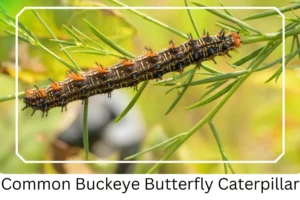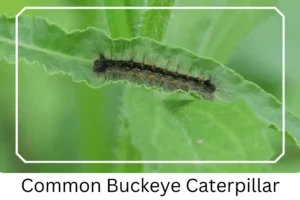Common Buckeye (Junonia coenia)
The Common Buckeye Butterfly is a captivating species of true brushfoot butterflies, renowned for their vibrant and distinctive eye-like markings on their wings. This butterfly is a frequent sight across many regions of the United States and Mexico, where it thrives in various open habitats. The unique appearance and behavior of the Common Buckeye make it a subject of interest for both enthusiasts and researchers alike.
Scientific Classification
- Family: Nymphalidae
- Genus: Junonia
- Common names: Buckeye
- Scientific Name: Junonia coenia
Overview
Belonging to the vast and diverse family of brushfoot butterflies, the Common Buckeye (Junonia coenia) exhibits several fascinating traits from its larval stage to adulthood. These butterflies are easily identifiable by their colorful markings and enjoy a wide distribution across the southern United States and much of Mexico. They are solitary creatures, with each stage of their life cycle offering a glimpse into the marvels of nature’s design.
Description and Identification
Caterpillar

The larval stage of the Common Buckeye can last between two and four weeks, during which the caterpillar can grow up to 1.5 inches in length. Its body is adorned with orange spots on a black base, highlighted by spine-like structures that protrude significantly. These spines have a striking blue hue at their bases, adding to the caterpillar’s distinctive appearance. Unlike many butterfly species, Common Buckeye caterpillars are solitary and do not engage in group behaviors.
Pupa
Transitioning into the pupal stage, the chrysalis of the Common Buckeye takes on a dark brown color, seamlessly blending into its surroundings like twigs and dry leaves for camouflage. This stage, lasting 1 to 2 weeks, features lighter brown patches and subtle dotted marks that enhance its mimicry of the natural environment.
Adult Butterfly
Sexual Dimorphism:
Adult Common Buckeyes exhibit sexual dimorphism, meaning that males and females can be distinguished by differences in their appearance.
Color and Appearance:
When their wings are open, the base color of both sexes is brown, with the forewings displaying two bright orange cell bars and two eyespots. The largest eyespot is found on the lower forewing. The hindwings feature two more eyespots, with the uppermost showing a magenta crescent. The underside of the hindwings varies seasonally in color from brown to tan in summer and to rose-red in autumn, with males sporting distinctive blue-to-black eye markings not present in females.
Average Wingspan:

The wingspan of the Common Buckeye ranges from 1.65 to 2.8 inches (4.2 to 7 cm), allowing for a swift and agile flight.
Flight Pattern:
These butterflies have a fast and periodic flight pattern, typically hovering around the low branches.
Eggs
The eggs of the Common Buckeye are tiny, green, and round, laid singly on the tender buds or upper sides of leaves, ensuring the next generation’s survival.
Quick Facts | |
| Distribution | Southern parts of the United States and much of Mexico. |
| Habitat | Prefers sunny meadows, open areas, fields, and clearings. |
| Lifespan of Adults | Ranges from 6 to 20 days. |
| Host Plants | Utilizes plants from the snapdragon, plantain, and acanthus families. |
| Adult Diet | Primarily consists of flower nectar from plants like tickseed sunflower, aster, gumweed, knapweed, and chicory. |
How to Identify Common Buckeye?
Identifying the Common Buckeye Butterfly is a rewarding experience for any nature enthusiast. Look for the characteristic eye-like markings on the wings, which are the butterfly’s most distinctive features. The combination of brown base coloration with bright orange bars and eyespots on the wings, especially the large lower eyespot on the forewings, makes identification straightforward. Seasonal changes in the coloration of the hindwing undersides also provide clues to their identification. Observing these traits, along with the butterfly’s unique flight pattern, can help differentiate the Common Buckeye from other species.
Did You Know?
- The striking eyespots on the Common Buckeye’s wings are not just for show; they play a crucial role in predator deterrence, mimicking the eyes of larger animals.
- Migration is a behavior observed mainly in the southern populations of the Common Buckeye. During late spring and summer, these butterflies migrate northward in search of optimal breeding conditions.
- Common Buckeye caterpillars have a diet rich in iridoid glycoside, a chemical compound that makes them less palatable to predators such as wasps, birds, and ants. This adaptation allows them to deter predators effectively, ensuring a higher survival rate.
Conclusion
The Common Buckeye Butterfly is more than just a beautiful sight; it is a fascinating subject for study and observation. From its vividly marked wings that deter predators to its unique lifecycle and behaviors, the Common Buckeye offers endless opportunities for discovery and appreciation. Whether you’re a seasoned butterfly enthusiast or a curious observer, the Common Buckeye Butterfly stands out as a remarkable example of nature’s ingenuity and beauty.
Common Buckeye Pictures

Scientific Classification

- Family: Nymphalidae
- Genus: Junonia
- Common names: Buckeye
- Scientific Name: Junonia coenia






